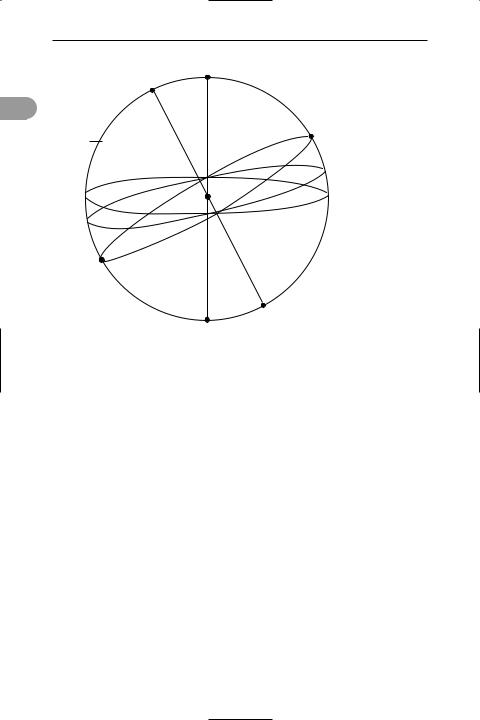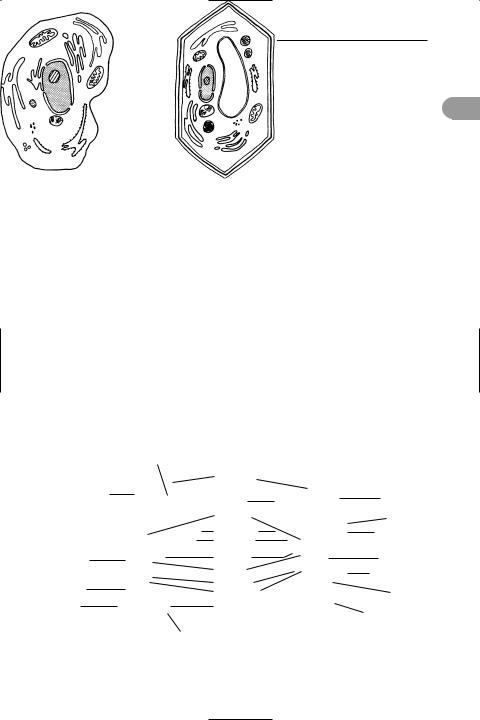
A Dictionary of Science
.pdf
carotid sinus |
136 |
blood lower the pH (i.e. increase the acidity). By responding to Ûuctuations in pH, the carotid body coordinates reÛex changes in respiration rate.
ccarotid sinus An enlarged region of the *carotid artery at its major branching point in the neck. Its walls contain many receptors that are sensitive to changes in
pressure and it regulates blood pressure by initiating reÛex changes in heart rate and dilation of blood vessels.
carpal (carpal bone) One of the bones that form the wrist (see carpus) in terrestrial vertebrates.
carpel The female reproductive organ of a Ûower. Typically it consists of a *stigma, *style, and *ovary. It is thought to have
evolved by the fusion of the two edges of a Ûattened megasporophyll (see sporophyll). Each Ûower may have one carpel (monocarpellary) or many (polycarpellary), either free (apocarpous) or fused together (syncarpous). See also pistil.
carpus The wrist (or corresponding part of the forelimb) in terrestrial vertebrates, consisting of a number of small bones (carpals). The number of carpal bones
varies with the species. The rabbit, for example, has two rows of carpals, the Ürst
(proximal) row containing three bones and the second (distal) row Üve. In hu-
mans there are also eight carpals. This large number of bones enables Ûexibility at the wrist joint, between the hand and forelimb. See also pentadactyl limb.
carrier 1. (in radio) See carrier wave.
2. (in physics) See charge carrier. 3. (in medicine) An individual who harbours a particular disease-causing microorganism without ill-effects and who can transmit the microorganism to others. Compare vector. 4. (in genetics) An individual with an *allele for some defective condition that is masked by a normal *dominant allele. Such individuals therefore do not suffer from the condition themselves but they may pass on the defective allele to their offspring. In humans, women may be carriers of such conditions as red–green colour blindness and haemophilia, the alleles for which are carried on the X chromosomes (see sex linkage).
5. (in biochemistry) See carrier molecule; hydrogen carrier.
carrier gas The gas that carries the sample in *gas chromatography.
carrier molecule 1. A molecule that plays a role in transporting electrons through the *electron transport chain. Carrier molecules are usually proteins bound to a nonprotein group; they can undergo oxidation and reduction relatively easily, thus allowing electrons to Ûow through the system. There are four types of carrier: Ûavoproteins (e.g. *FAD), *cytochromes, iron–sulphur proteins (e.g. ferredoxin), and *ubiquinone. 2. A lipidsoluble molecule that can bind to lipidinsoluble molecules and transport them across membranes. Carrier molecules have speciÜc sites that interact with the molecules they transport. Several different molecules may compete for transport by the same carrier. See transport protein.
carrier wave An electromagnetic wave of speciÜed frequency and amplitude that is emitted by a radio transmitter in order to carry information. The information is superimposed onto the carrier by means of *modulation.
carrying capacity Symbol K. The maximum population of a particular species that can be supported indeÜnitely by a given habitat or area without damage to the environment. It can be manipulated by human intervention. For example, the carrying capacity for grazing mammals could be increased by boosting the yield of their grassland habitat by the application of fertilizer. See also k selection.
Cartesian coordinates A system used in analytical geometry to locate a point P, with reference to two or three axes (see graphs). In a two-dimensional system the vertical axis is the y-axis and the horizontal axis is the x-axis. The point at which the axes intersect each other is called the origin, O. Values of y <0 fall on the y-axis below the origin, values of x <0 fall on the x-axis to the left of the origin. Any point P is located by its perpendicular distances from the two axes. The distance from the x-axis is called the ordinate; the distance from the y-axis is the abscissa. The posi-

137 |
cascade liquefier |
tion is indicated numerically by enclosing the values of the abscissa and the ordinate in parentheses and separating the two by means of a comma, e.g. (x,y). In three dimensions the system can be used to locate a point with reference to a third, z-axis. It is named after René Descartes (1596– 1650).
y
abscissa
P(x,y)
ordinate
– x |
O |
x |
– y
two-dimensional system
y
 P(x,y,z)
P(x,y,z)
y
x
z
x
z three-dimensional system
Cartesian coordinates
cartilage (gristle) A Ürm Ûexible connective tissue that forms the adult skeleton of cartilaginous Üsh (e.g. sharks). In other vertebrates cartilage forms the skeleton of the embryo, being largely replaced by *bone in mature animals (although it persists in certain areas). Cartilage comprises a matrix consisting chieÛy of a glycosaminoglycan (mucopolysaccharide) called chondroitin sulphate secreted by cells (chondroblasts) that become embedded in
the matrix as chondrocytes. It also contains collagenous and elastic Übres. Hyaline cartilage consists largely of glycosaminoglycan, giving it a shiny glasslike
appearance; this type of cartilage gives c Ûexibility and support at the joints. Fibrocartilage, in which bundles of collagen
Übres predominate, is stronger and less elastic than hyaline cartilage; it is found in such areas as the intervertebral discs. Elastic cartilage has a yellow appearance due to the presence of numerous elastic Übres (see elastin). This cartilage maintains the shape of certain organs, such as the pinna of the ear.
cartilage bone (replacing bone) *Bone that is formed by replacing the cartilage of an embryo skeleton. The process, called ossiÜcation, is brought about by the cells (osteoblasts) that secrete bone. Compare membrane bone.
cartilaginous Üshes See chon-
drichthyes.
cartography The science of the production of maps and charts. Maps may be based on original surveys, aerial photographs (photogrammetry), or compiled from existing maps and records. Com- puter-based information systems are increasingly used in the production of maps (digital cartography) in place of more traditional methods. See also map projections.
caruncle A small outgrowth from the testa of a seed that develops from the placenta, funicle, or micropyle. Examples include the warty outgrowth from the castor-oil seed and the tuft of hairs on the testa of the seed of willowherb. See also aril.
caryopsis A dry single-seeded indehiscent fruit that differs from an *achene in that the fruit wall is fused to the testa of the seed. It is the grain of cereals and grasses.
cascade liqueÜer An apparatus for liquefying a gas of low *critical temperature. Another gas, already below its critical temperature, is liquiÜed and evaporated at a reduced pressure in order to cool the Ürst gas to below its critical temperature. In practice a series of steps is often used,

cascade process |
138 |
each step enabling the critical temperature of the next gas to be reached.
cascade process Any process that takes place in a number of steps, usually be-
ccause the single step is too inefÜcient to produce the desired result. For example, in some uranium-enrichment processes the separation of the desired isotope is only poorly achieved in a single stage; to achieve better separation the process has to be repeated a number of times, in a series, with the enriched fraction of one stage being fed to the succeeding stage for further enrichment. Another example of
cascade process is that operating in a *cascade liqueÜer.
case hardening The hardening of the surface layer of steel, used for tools and certain mechanical components. The commonest method is to carburize the surface layer by heating the metal in a hydrocarbon or by dipping the red hot metal into molten sodium cyanide. Diffusion of nitrogen into the surface layer to form nitrides is also used.
casein One of a group of phosphatecontaining proteins (phosphoproteins) found in milk. Caseins are easily digested by the enzymes of young mammals and represent a major source of phosphorus.
See rennin.
Cassegrainian telescope See telescope.
Cassini, Giovanni Domenico
(1625–1712) Italian-born French astronomer, who was professor of astronomy at Bologna. In 1669 he moved to Paris to run the new observatory there, becoming a French citizen in 1673. He is best known for his discovery (1675) of the gap that divides Saturn’s ring system into two parts, now called the Cassini division. He also discovered four new satellites of Saturn.
cassiterite A yellow, brown, or black
form of tin(IV) oxide, SnO2, that forms tetragonal, often twinned, crystals; the principal ore of tin. It occurs in hydrothermal veins and metasomatic deposits associated with acid igneous rocks and in alluvial (placer) deposits. The chief producers are Malaysia, Indonesia, Democratic Republic of Congo, and Nigeria.
caste A division found in social insects, such as the *Hymenoptera (ants, bees, wasps) and the Isoptera (termites), in which the individuals are structurally and physiologically specialized to perform a particular function. For example, in honeybees there are queens (fertile females), workers (sterile females), and drones (males). There are several different castes of workers (all sterile females) among ants.
cast iron A group of iron alloys containing 1.8 to 4.5% of carbon. It is usually cast into speciÜc shapes ready for machining, heat treatment, or assembly. It is sometimes produced direct from the *blast furnace or it may be made from remelted *pig iron.
castor oil A pale-coloured oil extracted from the castor-oil plant. It contains a mixture of glycerides of fatty acids, the predominant acid being ricinoleic acid, C17H32(OH)COOH. It is used as a *drying oil in paints and varnishes and medically as a laxative.
catabolism The metabolic breakdown of large molecules in living organisms to smaller ones, with the release of energy. Respiration is an example of a catabolic series of reactions. See metabolism. Compare anabolism.
catalysis The process of changing the rate of a chemical reaction by use of a *catalyst.
catalyst A substance that increases the rate of a chemical reaction without itself undergoing any permanent chemical change. Catalysts that have the same phase as the reactants are homogeneous catalysts (e.g. *enzymes in biochemical reactions or transition-metal complexes used in the liquid phase for catalysing organic reactions). Those that have a different phase are hetereogeneous catalysts
(e.g. metals or oxides used in many industrial gas reactions). The catalyst provides an alternative pathway by which the reaction can proceed, in which the activation energy is lower. It thus increases the rate at which the reaction comes to equilibrium, although it does not alter the position of the equilibrium. The catalyst itself takes part in the reaction and conse-

139 |
cathode-ray oscilloscope |
quently may undergo physical change (e.g. conversion into powder). In certain circumstances, very small quantities of catalyst can speed up reactions. Most catalysts are also highly speciÜc in the type of reaction they catalyse, particularly enzymes in biochemical reactions. Generally, the term is used for a substance that increases reaction rate (a positive catalyst). Some reactions can be slowed down by negative catalysts (see inhibition).
catalytic activity The increase in the rate of a speciÜed chemical reaction caused by an enzyme or other catalyst under speciÜed assay conditions. It is measured in *katals or in moles per second.
catalytic converter A device used in the exhaust systems of motor vehicles to reduce atmospheric pollution. The three main pollutants produced by petrol engines are: unburnt hydrocarbons, carbon monoxide produced by incomplete combustion of hydrocarbons, and nitrogen oxides produced by nitrogen in the air reacting with oxygen at high engine temperatures. Hydrocarbons and carbon monoxide can be controlled by a higher combustion temperature and a weaker mixture. However, the higher temperature and greater availability of oxygen arising from these measures encourage formation of nitrogen oxides. The use of three-way catalytic converters solves this problem by using platinum and palladium catalysts to oxidize the hydrocarbons and the CO and rhodium catalysts to reduce the nitrogen oxides back to nitrogen. These three-way catalysts require that the air–fuel ratio is strictly stochiometric. Some catalytic converters promote oxidation reactions only, leaving the nitrogen oxides unchanged. Three-way converters can reduce hydrocarbons and CO emissions by some 85%, at the same time reducing nitrogen oxides by 62%.
catalytic cracking See cracking.
catalytic RNA See ribozyme.
cataphoresis See electrophoresis.
catastrophe theory A branch of mathematics dealing with the sudden emergence of discontinuities, in contrast to *calculus, which is concerned with con-
tinuous quantities. Catastrophe theory |
|
|
|
originated in *topology in work by the |
|
|
|
French mathematician René Thom |
|
|
|
(1923–2002) and was developed by Thom |
|
|
|
and the Russian mathematician Vladimir |
|
|
|
c |
|
||
Igorevich Arnold (1937– ). There are |
|
||
|
|||
physical applications of catastrophe |
|
|
|
theory in *optics and in systems involving |
|
|
|
*complexity, including biological systems. |
|
|
|
catechol See 1,2-dihydroxybenzene. |
|
|
|
catecholamine Any of a class of amines |
|
|
|
that possess a catechol (C6H4(OH)2) ring. |
|
|
|
Including *dopamine, *adrenaline, and |
|
|
|
*noradrenaline, they function as *neuro- |
|
|
|
transmitters and/or hormones. |
|
|
|
category (in taxonomy) See rank. |
|
|
|
catenary A curve formed when a chain |
|
|
|
or rope of uniform density hangs from |
|
|
|
two Üxed points. If the lowest point on |
|
|
|
the curve passes through the origin, the |
|
|
|
equation is y = c(coshx/c), where c is the |
|
|
|
distance between the x-axis and the direc- |
|
|
|
trix. |
|
|
|
catenation The formation of chains of |
|
|
|
atoms in chemical compounds. |
|
|
|
cathetometer A telescope or micro- |
|
|
|
scope Ütted with crosswires in the eye- |
|
|
|
piece and mounted so that it can slide |
|
|
|
along a graduated scale. Cathetometers |
|
|
|
are used for accurate measurement of |
|
|
|
lengths without mechanical contact. The |
|
|
|
microscope type is often called a travel- |
|
|
|
ling microscope. |
|
|
|
cathode A negative electrode. In *elec- |
|
|
|
trolysis cations are attracted to the cath- |
|
|
|
ode. In vacuum electronic devices |
|
|
|
electrons are emitted by the cathode and |
|
|
|
Ûow to the *anode. It is therefore from |
|
|
|
the cathode that electrons Ûow into these |
|
|
|
devices. However, in a primary or sec- |
|
|
|
ondary cell the cathode is the electrode |
|
|
|
that spontaneously becomes negative dur- |
|
|
|
ing discharge, and from which therefore |
|
|
|
electrons emerge. |
|
|
|
cathode-ray oscilloscope (CRO) An in- |
|
|
|
strument based on the *cathode-ray tube |
|
|
|
that provides a visual image of electrical |
|
|
|
signals. The horizontal deÛection is usu- |
|
|
|
ally provided by an internal *timebase, |
|
|
|
which causes the beam to sweep across |
|
|
|
the screen at a speciÜed rate. The signal to |
|
|
|
be investigated is fed to the vertical deÛec- |
|
|

cathode rays |
140 |
tion plates after ampliÜcation. Thus the beam traces a graph of the signal amplitude against time.
cathode rays Streams of electrons
cemitted at the cathode in an evacuated tube containing a cathode and an anode. They were Ürst observed in gas *discharge tubes operated at low pressure. Under suitable conditions electrons produced by secondary emission at the cathode are accelerated down the tube to the anode. In such devices as the *cathode-ray tube the electrons are produced by *thermionic emission from a hot cathode in a vacuum.
cathode-ray tube (CRT) The device that provides the viewing screen in the television tube, the radar viewer, and the *cath- ode-ray oscilloscope. The cathode-ray tube consists of an evacuated tube containing a heated cathode and two or more ringshaped anodes through which the cathode rays can pass so that they strike the enlarged end of the tube (see illustration).
This end of the tube is coated with Ûuorescent material so that it provides a screen. Any point on the screen that is struck by the cathode ray becomes luminous. A *control grid between the cathode and the anode enables the intensity of the beam to be varied, thus controlling the brightness of the illumination on the screen. The assembly of cathode, control grid, and anode is called the *electron
gun. The beam emerging from the electron gun is focused and deÛected by means of plates providing an electric Üeld or coils providing a magnetic Üeld. This
enables the beam to be focused to a small point of light and deÛected to produce the
vertical deflection
cathode anode plates
control |
focusing |
horizontal |
grid |
anode |
deflection |
|
|
plates |
luminous screen
Cathode-ray tube
illusion of an illuminated line as this point sweeps across the tube.
The television tube is a form of cathoderay tube in which the beam is made to scan the screen 625 times to form a frame, with 25 new frames being produced every second. (These are the Ügures for standard television tubes in the UK). Each frame creates a picture by variations in the intensity of the beam as it forms each line.
cathodic protection See sacrificial protection.
cation A positively charged ion, i.e. an ion that is attracted to the cathode in *electrolysis. Compare anion.
cationic detergent See detergent.
cationic dye See dyes.
cationic resin See ion exchange.
catkin A type of Ûowering shoot (see racemose inflorescence) in which the axis, which is often long, bears many small stalkless unisexual Ûowers. Usually the male catkins hang down from the stem; the female catkins are shorter and often erect. Examples include birch and hazel. Most plants with catkins are adapted for wind pollination, the male Ûowers producing large quantities of pollen; willows are an exception, having nectar-secreting Ûowers and being pollinated by insects.
caudal vertebrae The bones (see vertebra) of the tail, which articulate with the *sacral vertebrae. The number of caudal vertebrae varies with the species. Rabbits, for example, have 15 caudal vertebrae, while in humans these vertebrae are fused to form a single bone, the *coccyx.
causality The principle that effect cannot precede cause. The principle is particularly useful when combined with the principle that the highest attainable speed in the universe is the *speed of light in a vacuum. Causality is used to analyse the results of scattering experiments and in optics.
caustic 1. (in chemistry) Describing a substance that is strongly alkaline (e.g. caustic soda). 2. (in optics) The curve or surface formed by the reÛection of paral-

141 |
celestial equator |
lel rays of light in a large-aperture concave mirror. The apex of the caustic lies at the principal focus of the mirror. Such a curve can sometimes be seen on the surface of the liquid in a cup as a result of reÛection by the curved walls of the cup. A similar curve is formed by a convex lens with spherical surfaces refracting parallel rays of light.
caustic potash See potassium hydroxide.
caustic soda See sodium hydroxide.
Cavendish, Henry (1731–1810) British chemist and physicist, born in France. Although untrained, his inheritance from his grandfather, the Duke of Devonshire, enabled him to live as a recluse and study science. In his experiments with gases (1766), he correctly distinguished between hydrogen and carbon dioxide, and in 1781 synthesized water by exploding hydrogen in oxygen. He also constructed a torsion balance in 1798, with which he measured the mean density (and hence mass) of the earth.
cavitation The formation of gasor vapour-Ülled cavities in liquids in motion when the pressure is reduced to a critical value while the ambient temperature remains constant. If the velocity of the Ûowing liquid exceeds a certain value, the pressure can be reduced to such an extent that the *Bernoulli theorem breaks down. It is at this point that cavitation occurs, causing a restriction on the speed at which hydraulic machinery can be run without noise, vibration, erosion of metal parts, or loss of efÜciency.
cavity resonator See resonant cavity.
C cell (parafollicular cell) Any one of a group of calcium-secreting cells in vertebrates that are derived from the terminal pair of gill pouches. In mammals these cells are incorporated into the *thyroid gland and the *parathyroid gland.
c.c.p. Cubic close packing. See close packing.
CD 1. (cluster of differentiation) Any group of antigens that is associated with a speciÜc subpopulation of human *T cells. The differentiation antigens expressed by a T cell vary with its stage of development
and thus with its role in the immune response. Hence, for example, CD4 antigens are expressed by helper T cells, whereas CD8 antigens are expressed by cytotoxic
and suppressor T cells. The antigens are c glycoproteins and are characterized using *monoclonal antibodies. 2. See compact
disk.
CD-I CD interactive. A variant of *CDROM in which data, sound, and images can be interleaved on the same disk, i.e. it is a *multimedia disk. It was designed as a ‘buy and play’ system for the home.
cDNA See complementary dna.
CD-ROM CD read-only memory. A device that is based on the audio *compact disk and provides read-only access to a large amount of data (up to 640 megabytes) for use on computer systems. The term also refers to the medium in general. A CDROM drive must be used with the computer system to read the data from disk; the data cannot normally be rewritten. Most drives can also play CD audio disks, but audio disk players cannot handle CDROMs. The data may be in any form – text, sound, images, or binary data, or a mixture – and various CD-ROM format standards exist to handle these. CD-ROM is widely used for the distribution of data, images, and software and for archiving data.
CD-RW CD-rewritable, a CD format launched around 1997 that enabled recording and re-use of CDs. CD-RW uses a phase change to record data. The recording layer is a special alloy (typically silver/indium/antimony/tellurium). The laser in the CD drive has three power levels. The highest level melts small regions of the recording layer and these cool quickly to an amorphous form, thereby creating small pits in the recording surface. This level is used for writing data to the disk. The intermediate power level heats the surface to a temperature below the melting point, but high enough to cause recrystallization of the amorphous pits. This is used for erasing data. The lowest power level is used for reading data from the disk in the same way that data is read from a CD-ROM.
celestial equator See equator.

celestial mechanics |
142 |
|
north celestial |
|
pole |
zenith |
|
c |
|
observer‘s |
N |
meridian |
|
observer
ecliptic celestial equator
horizon
S
nadir
south celestial pole
Celestial sphere
celestial mechanics The study of the motions of and forces between the celestial bodies. It is based on *Newton’s laws of motion and *Newton’s law of gravitation. ReÜnements based on the general theory of *relativity are also included in the study, although the differences between the two theories are only important in a few cases.
celestial sphere The imaginary sphere of inÜnite radius within which celestial bodies appear to lie. The earth, and the observer, are visualized as being at the centre of the sphere and the sphere as rotating once every sidereal *day (see illustration). The sphere is used to describe the position of celestial bodies with respect to the earth.
celestine A mineral form of strontium sulphate, SrSO4.
cell (in physical chemistry) 1. A system in which two electrodes are in contact with an electrolyte. The electrodes are metal or carbon plates or rods or, in some cases, liquid metals (e.g. mercury). In an
*electrolytic cell a current from an outside source is passed through the electrolyte to produce chemical change (see electrolysis). In a *voltaic cell, spontaneous reactions between the electrodes and electrolyte(s) produce a potential difference between the two electrodes.
Voltaic cells can be regarded as made up of two *half cells, each composed of an electrode in contact with an electrolyte. For instance, a zinc rod dipped in zinc sulphate solution is a Zn|Zn2+ half cell. In such a system zinc atoms dissolve as zinc ions, leaving a negative charge on the electrode
Zn(s) → Zn2+(aq) + 2e
The solution of zinc continues until the charge build-up is sufÜcient to prevent further ionization. There is then a potential difference between the zinc rod and its solution. This cannot be measured directly, since measurement would involve making contact with the electrolyte, thereby introducing another half cell (see electrode potential). A rod of copper in copper sulphate solution comprises an-

143 |
cell |
other half cell. In this case the spontaneous reaction is one in which copper ions in solution take electrons from the electrode and are deposited on the electrode as copper atoms. In this case, the copper acquires a positive charge.
The two half cells can be connected by using a porous pot for the liquid junction (as in the *Daniell cell) or by using a salt bridge. The resulting cell can then supply current if the electrodes are connected through an external circuit. The cell is written
Zn(s)|Zn2+(aq)|Cu2+(aq)|Cu E = 1.10 V
Here, E is the e.m.f. of the cell equal to the potential of the right-hand electrode minus that of the left-hand electrode for zero current. Note that ‘right’ and ‘left’ refer to the cell as written. Thus, the cell could be written
Cu(s)|Cu2+(aq)|Zn2+(aq)|Zn(s) E = –1.10 V
The overall reaction for the cell is
Zn(s) + Cu2+(aq) → Cu(s) + Zn2+(aq)
This is the direction in which the cell reaction occurs for a positive e.m.f.
The cell above is a simple example of a chemical cell; i.e. one in which the e.m.f. is produced by a chemical difference. Concentration cells are cells in which the e.m.f. is caused by a difference of concentration. This may be a difference in con-
centration of the electrolyte in the two half cells. Alternatively, it may be an electrode concentration difference (e.g. different concentrations of metal in an
amalgam, or different pressures of gas c in two gas electrodes). Cells are also
classiÜed into cells without transport (having a single electrolyte) and with transport (having a liquid junction across which ions are transferred). Various types of voltaic cell exist, used as sources of current, standards of potential, and experimental set-ups for studying electrochemical reactions. See also dry cell; primary cell; secondary cell.
2. See photoelectric cell. 3. See solar cell. 4. See kerr effect (for Kerr cell).
cell (in biology) The structural and functional unit of most living organisms (compare coenocyte; syncytium). Cell size varies, but most cells are microscopic (average diameter 0.01–0.1 mm). Cells may exist as independent units of life, as in bacteria and certain protoctists, or they may form colonies or tissues, as in all plants and animals. Each cell consists of a mass of protein material that is differentiated into *cytoplasm and a *nucleus, which contains DNA. The cell is bounded by a *plasma membrane, which in the cells of plants, fungi, algae, and bacteria is surrounded by a *cell wall. There are two main types of cell. Prokaryotic cells (bac-
Golgi apparatus |
smooth |
|
|
|
|
||
|
endoplasmic |
|
|
|
reticulum |
|
|
mitochondrion |
cellulose |
chloroplast |
|
|
cell wall |
||
|
|
||
|
nucleolus |
ribosome |
|
|
plasma |
||
|
rough |
||
|
membrane |
||
|
cytoplasm |
endoplasmic |
|
|
nuclear |
reticulum |
|
lysosome |
cell vacuole |
||
envelope |
|||
|
nucleus |
mitochondrion |
|
glycogen |
|
||
centrioles |
starch |
||
granules |
centrosome |
||
fat |
|
granules |
|
rough |
Golgi apparatus |
||
droplets |
endoplasmic |
||
|
reticulum |
|
|
ribosome |
|
|
|
animal |
|
plant |
Generalized eukaryotic cells

cell body |
144 |
CELL BIOLOGY
1665 English physicist Robert Hooke (1635–1703) coins the word ‘cell’.
c1831 Robert Brown discovers the nucleus in plant cells.
1838 German botanist Matthias Schleiden (1804–81) proposes that plants are composed of cells.
1839 Theodor Schwann states that animals are composed of cells and concludes that all living things are made up of cells.
1846 German botanist Hugo von Mohl (1805–72) coins the word ‘protoplasm’ for the living material of cells.
1858 German pathologist Rudolf Virchow (1821–1902) postulates that all cells arise from other cells.
1865 German botanist Julius von Sachs (1832–97) discovers the chlorophyllcontaining bodies in plant cells later named chloroplasts.
1876–80 German cytologist Eduard Strasburger (1844–1912) describes cell division in plants and states that new nuclei arise from division of existing nuclei.
1882 German cytologist Walther Flemming (1843–1905) describes the process of cell division in animal cells, for which he coins the term ‘mitosis’. Strasburger coins the words ‘cytoplasm’ and ‘nucleoplasm’.
1886 German biologist August Weismann (1834–1914) proposes his theory of the continuity of the germ plasm.
1887 Belgian cytologist Edouard van Beneden (1846–1910) discovers that the number of chromatin-containing threadlike bodies (subsequently named chromosomes) in the cells of a given species is always the same and that the sex cells contain half this number.
1888 German anatomist Heinrich von Waldeyer (1836–1921) coins the word ‘chromosome’.
1898 Camillo Golgi discovers the Golgi apparatus.
1901 US biologist Clarence McClung (1870–1946) discovers the sex chromosomes.
1911 Thomas Hunt Morgan produces the first chromosome map.
1949 Canadian geneticist Murray Barr (1908–95) discovers Barr bodies.
1955 |
Belgian biochemist Christian de Duve (1917– ) discovers lysosomes and |
|
peroxisomes. |
1956 |
Romanian-born US physiologist George Palade (1912– ) discovers the |
|
role of microsomes (later renamed ribosomes). |
teria) are the more primitive. The nuclear material is not bounded by a membrane and chemicals involved in cell metabolism are associated with the plasma membrane. Reproduction is generally asexual and involves simple cell cleavage. In eukaryotic cells the nucleus is bounded by a nuclear envelope and the cytoplasm is divided by membranes into a system of
interconnected cavities and separate compartments (organelles), e.g. *mitochondria, *endoplasmic reticulum, *Golgi apparatus, *lysosomes, and *ribosomes (see illustration). Reproduction can be either asexual (see mitosis) or sexual (see meiosis). Plants and animals consist of eukaryotic cells but plant cells possess *chloroplasts and other *plastids and bear

145 |
cell cycle |
1956 |
US biochemist Arthur Kornberg (1918– |
) discovers DNA polymerase. |
|
|
|
|
1957 |
US biochemist Melvin Calvin (1911–97) publishes details of the |
|
|
c |
|
|
|
photosynthetic carbon-fixation cycle (Calvin cycle). |
|
|
|
|
|
1961 |
South African-born British biochemist Sydney Brenner (1927– ) |
|
|
|
|
|
|
discovers messenger RNA, in conjunction with François Jacob (1920– |
) |
|
|
|
|
|
and Mathews Meselson (1930– ). |
|
|
|
|
|
1964 |
US microbiologists Keith Porter and Thomas F. Roth discover the first cell |
|
||||
|
receptors. |
|
|
|
|
|
1970 |
US biologist Lynn Margulis (1938– ) proposes the endosymbiont theory |
|
||||
|
for the origin of eukaryote cellular organelles. |
|
|
|
|
|
1971 |
German-born US cell biologist Günter Blobel (1936– ) proposes the |
|
|
|
|
|
|
signal hypothesis to explain how proteins are delivered to their correct |
|
|
|
|
|
|
destinations within cells. |
|
|
|
|
|
1975 |
British biologists J. A. Lucy and E. C. Cocking achieve successful fusion of |
|
||||
|
plant and animal cells. |
|
|
|
|
|
1979 |
The first ‘test-tube baby’, Louise Brown, is born in the UK using in vitro |
|
|
|
|
|
|
fertilization. |
|
|
|
|
|
1982 |
British cell biologist Timothy Hunt (1943– ) discovers cyclins, proteins |
|
|
|
|
|
|
that control the cell cycle. |
|
|
|
|
|
|
US neurologist Stanley Prusiner (1942– |
) discovers prions. |
|
|
|
|
1983 |
A mouse embryo is engineered to include the gene for human growth |
|
|
|
|
|
|
hormone, creating a ‘supermouse’. |
|
|
|
|
|
1984 |
Sheep embryos are cloned for the first time. |
|
|
|
|
|
1986 |
US cell biologist Robert Horvitz (1947– |
) identifies genes involved in |
|
|
|
|
|
programmed cell death in the nematode Caenorhabditis elegans. |
|
|
|
|
|
|
First licence granted in USA for marketing a genetically engineered |
|
|
|
|
|
|
organism. |
|
|
|
|
|
1993 |
First successful cloning of human embryos. |
|
|
|
|
|
1997 |
Birth of Dolly the sheep, the first mammal to be cloned from adult body |
|
||||
|
cells. |
|
|
|
|
|
1998 |
Approval given in USA for therapeutic use of a synthetic skin |
|
|
|
|
|
|
containing live cultured human tissue cells. |
|
|
|
|
|
2000 |
The embryo of a gaur, an endangered mammal, is cloned from skin cells |
|
||||
|
of an adult and develops inside the womb of a cow. |
|
|
|
|
|
2002 |
A pluripotent stem cell is isolated from adult human bone marrow. |
|
|
|
|
|
|
|
|
|
|
|
|
a rigid cellulose cell wall. See Chronology: Cell Biology.
cell body (perikaryon) The part of a
*neuron that contains the nucleus. The cell processes that are involved in the transmission and reception of nervous impulses (the axon and the dendrites respectively) develop as extensions from the cell body.
cell cycle The sequence of stages that a cell passes through between one cell division and the next. The cell cycle can be divided into four main stages: (1) the M phase, which consists of *mitosis (nuclear division) and cytokinesis (cytoplasmic division); (2) the G1 phase, in which there is a high rate of biosynthesis and growth; (3) the S phase, in which the DNA content of
